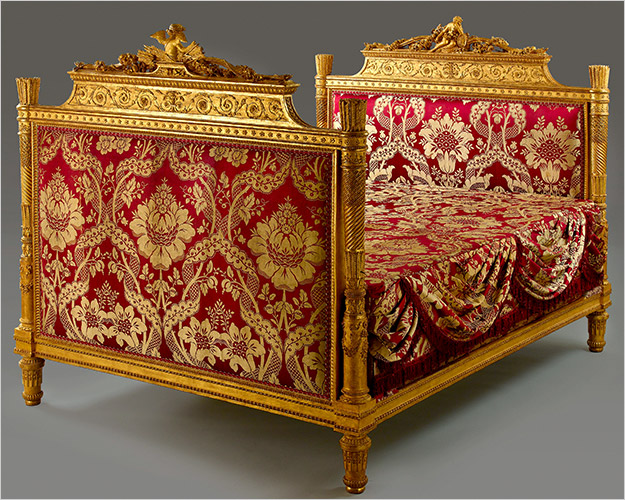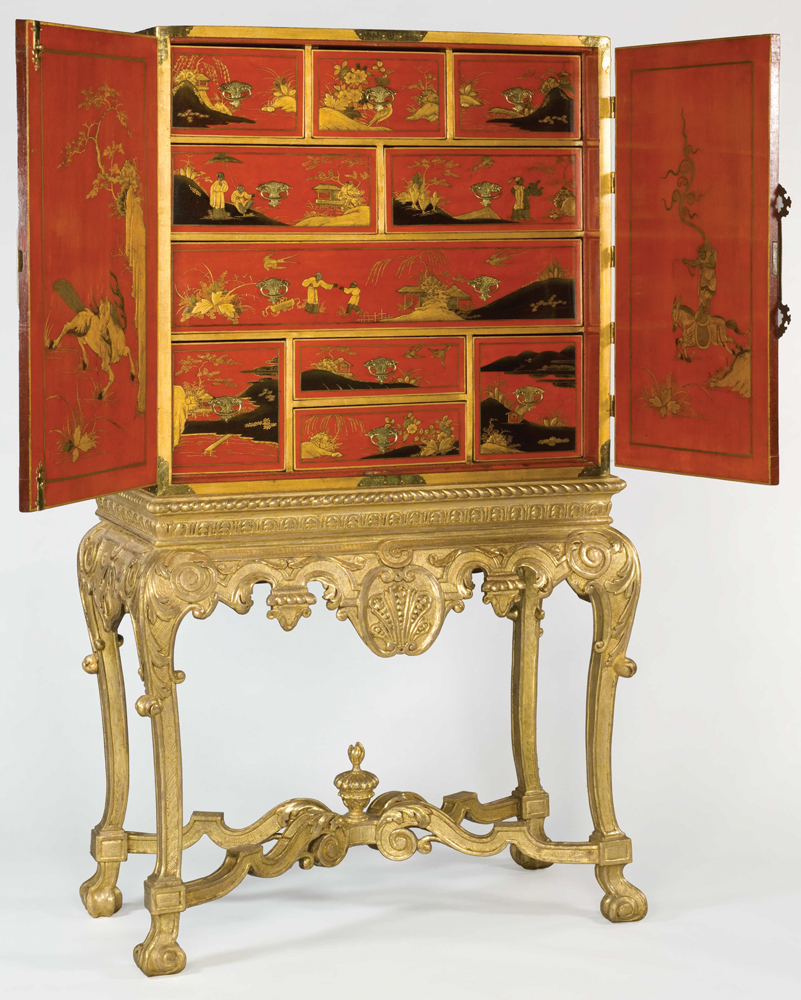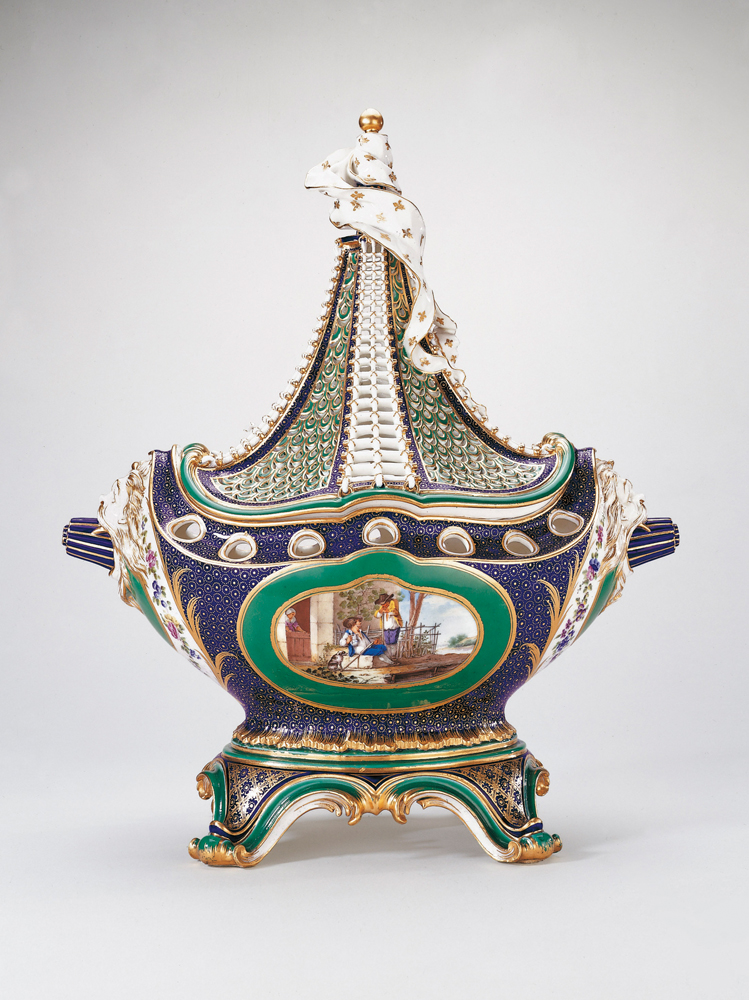
As the sun comes out of hiding, London’s season gets into full swing. Amidst the social swirl of Royal Ascot, the Chelsea Flower Show, and Wimbledon, the venerable Grosvenor House Art and Antiques Fair remains a perennial highlight. Olympia, the daughter of that seminal show, has now matured into a formidable event of its own. As always, this year a number of other exhibitions will also vie for attention. The Queen’s Gallery display of Sèvres from the Royal Collection will hold special appeal for porcelain aficionados even as, more broadly, it illustrates that English collecting has long extended to objects produced beyond the confines of the British Isles.
Olympia
Thirty-six years ago, the Olympia International Art and Antiques Fair began as a means for younger, less established dealers, who were excluded from the select ranks of Grosvenor House, to showcase their wares in the week prior to and overlapping with the latter fair. Retired dealer of Chinese works of art Odile Kern (wife of Robin Kern, former director of Hotspur, the eminent English furniture gallery, which closed last summer) recalls the early years of Olympia as being “fun and energetic.” Over time, its importance and quality have increased—although some, including Odile Kern, regret that in its efforts to compete with the Grosvenor House fair, Olympia has lost some of the light-heartedness of earlier years.
Approximately 260 dealers now show objects and fine art ranging from ancient Chinese ceramics to twentieth-century European design classics at the Olympia fair. Among them, Pelham Galleries, a renowned dealer in European furniture, musical instruments, and other decorative objects, two years ago abandoned its coveted booth at Grosvenor House to show at Olympia instead. Dennis Harrington of the firm explained that over the past couple of decades Pelham has veered more toward Continental pieces as opposed to the classic English furniture for which Grosvenor House is particularly known. They therefore decided that the more eclectic atmosphere of Olympia was a better fit. That this white-shoe gallery, established in 1928, gave up Grosvenor House for Olympia points to just how much the latter fair has come into its own.
In addition at Olympia booklovers can flock to the Antiquarian Book Fair from June 4 to 6, where 150 leading booksellers will present their best books, manuscripts, maps, prints, and photographs.
Olympia International Art and Antiques Fair · Olympia Exhibition Centre, London June 5-14 · www.olympiaartsinternational.com
Grosvenor House
The Grosvenor House Art and Antiques Fair celebrates its seventy-fifth anniversary this year. Restricted to an elite group of ninety dealers that can fit into the great room of Grosvenor House, the show has long set the gold standard for highly edited, vetted fairs and is especially renowned for the finest English furniture and decorative arts. As ever, royal patronage assures that its annual charity gala will be a glittering event on the social calendar. This year, Camilla, the Duchess of Cornwall, will preside over the June 11 gala to benefit the National Osteoporosis Society.
Fashions have changed, however, with a notable downturn in interest in “brown furniture.” Over the past year, three leading English furniture galleries have shuttered their doors, abandoning their pivotal booths at Grosvenor House in the process. Hotspur (founded 1924) and Jeremy (founded in 1946) jointly sold off their inventory at Christie’s this past November. Then, in January, eighteenth-century English furniture dealer Norman Adams, which has exhibited at every Grosvenor House fair since 1934, announced that it also would close and auction off its stock at Sotheby’s.

So too, the myriad rival shows, such as BADA, Brussels, and Milan, that have sprung up since Grosvenor House’s inception have increased competition. If Olympia, just a short cab ride away, is the obvious example, Maastricht’s ascendancy has also dimmed Grosvenor House’s luster.
Has Grosvenor House lost its relevance? For many, it remains Britain’s preeminent fair. If some have dropped out to head to Olympia, the traffic appears to be moving in both directions. Timo Koopman of Koopman Rare Art, which has shown at Olympia since it began and which has taken booths at both fairs for the past two years, explains that he has dropped Olympia this year to concentrate exclusively on Grosvenor House. In a concerted effort to stay current, the fair and its exhibitors have expanded their focus beyond the tried and true stalwart of English furniture. Henry Neville of Mallett considers Grosvenor House to be “still the core of the English decorative arts market” and thinks that it is neither as stuffy nor as bland as some claim. He finds that objects with a bit of fantasy do well there. At last year’s fair he sold several editions of the strikingly contemporary lantern “Diamonds are a Girl’s Best Friend 1” designed by Matali Crasset for the firm’s then newly launched subsidiary, META, which he displayed alongside the eighteenth-century English antiques for which Mallett has long been known. This year he again plans to juxtapose new and old in his booth.
Indeed, Grosvenor House’s organizers bill their 2009 show as “more diverse than ever.” Although British art and decorative arts remain central, this year’s fair will include modern furniture, brought by Peter Petrou; original film posters, displayed by the Reel Poster Gallery; and European furniture and works of art, shown by returning exhibitor Antoine Chenevière as well as by newcomer Sinai and Sons. Similarly, the antique jewels and objets de vertu on view from dealers such as Wartski, S. J. Philips, and Hancocks and Company will this year be complemented by contemporary pieces brought by first-time exhibitor Symbolic and Chase.
Fine art will range from a sixteenth-century portrait of Edward VI, being offered by Philip Mould to contemporary works, such as Edouard Martinet’s sculpture Grasshopper, on view in the Sladmore Gallery’s stand. Agnew’s returns to the fair after an absence of several years with modern British art; first-timers Robert Bowman and Stephen Ongpin Fine Art will exhibit nineteenth-century British sculpture and nineteenth-century watercolors and drawings, respectively. The latter will also show a rare illustrated letter from Édouard Manet to collector Albert Hecht. Photography, introduced at the fair for the first time last year, will be displayed by returning exhibitor Hamiltons Gallery.
The Grosvenor House Art and Antiques Fair, which began as a means to jumpstart the art and antiques trade in the midst of the Great Depression, appears eager to attempt the same in these difficult times.
In addition, at Grosvenor House there is also the International Ceramics Fair and Seminar, in its twenty-seventh year, which will run from June 11 to June 14.
Grosvenor House Art and Antiques Fair · Great Room of Grosvenor House, JW Marriott Hotel, Park Lane, London June 11-17 · www.grosvenorfair.co.uk
Royal porcelain
Opening in advance of the fairs and carrying on through the summer, the exhibition French Porcelain for English Palaces: Sèvres from the Royal Collection at the Queen’s Gallery, Buckingham Palace, will include three hundred breathtaking pieces, most of which were acquired by George IV, who is both revered and loathed for his extravagant collecting.
At the age of twenty-one, when still Prince of Wales, George made his first purchase from the Sèvres factory; he continued to buy its wares until shortly before his death in l830, notably acquiring the vase royal and four other vases at Lord Gwydir’s sale on May 20, 1829. Ornamental pieces as well as tablewares were prominently displayed at Carlton House and his other residences.

While the opulent, richly decorated pieces purchased by George IV bear witness to his lavish taste for bold colors and ornate decor, the exhibition also sheds light on French collecting of the porcelain that was so intimately linked to its royal family from 1745 when Louis XV—through the encouragement of his mistress, the cultivated Madame de Pompadour—granted the manufactory, then still located in Vincennes, the exclusive royal license to make and gild porcelain, which it retained until the French Revolution of 1789. Included are a vase probably purchased by another Louis XV mistress Madame du Barry and bearing a profile portrait of the king; a garniture of three vases first acquired by Marie Antoinette (and recently reunited through a purchase by Elizabeth II); portions of a dinner service made for Louis XVI, the most expensive created at Sèvres in the eighteenth century; and a pair of mounted vases produced for the king’s private apartments at Versailles. Exemplifying French royal taste, these works simultaneously attest to the French influence on the English court when large quantities of these rarified objects crossed the Channel in the tumultuous aftermath of the Revolution.
The magnificent porcelain-mounted Table of the Grand Commanders, made for Napoleon I and subsequently given to George IV by Louis XVIII, reveals that such royal exchanges continued even after Alexandre Brongniart reorganized the factory in 1800. Its meticulously painted medallion portrait busts and tooled, burnished gilding on a slick, hard-paste surface showcase the new techniques and aesthetic introduced at that time. Placed on display in the sumptuous Rose Satin Drawing Room of Carlton House upon its arrival there and later serving as part of the backdrop to an 1821 state portrait of the king by Sir Thomas Lawrence, the table evidently pleased the English monarch greatly.
This exhibition, drawn from a collection of Sèvres that is widely esteemed as perhaps the finest in the world, abounds with tour-de-force pieces that accumulatively reveal the factory’s diverse aesthetic range and technical brilliance. Joanna Gwilt has written an illustrated guide to accompany the show, which also coincides with the publication of the three-volume catalogue raisonné, French Porcelain in the Collection of Her Majesty The Queen by Sir Geoffrey de Bellaigue.
French Porcelain for English Palaces: Sèvres from the Royal Collection · Queen’s Gallery, Buckingham Palace, London May 23 to October 11 · www.royalcollection.org.uk
